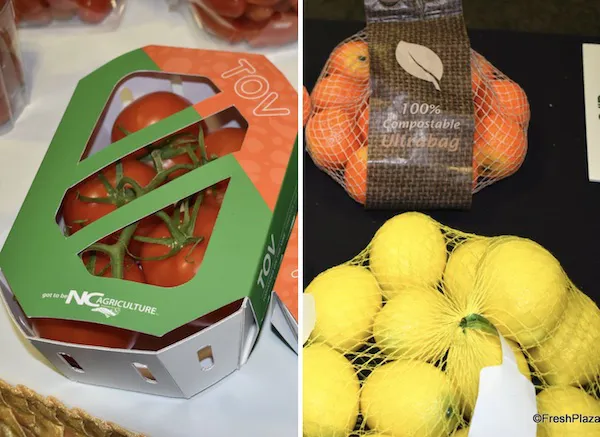Packaging is a topic that has been getting a lot of attention in past years. The focus on sustainable packaging was primary for many in the produce industry up until a few months ago, but when the pandemic hit, a major shift was seen: a consumer preference toward packaged produce. This week’s PMA virtual town hall focused on sustainable packaging: the trends we were seeing prior to the pandemic, the shift in the demand since the onset of the pandemic, and what to expect in the future.

Left: Lakeside Produce's 100% recyclable packaging; Right: Giro Pack's 100% compostable produce bag.
Balancing sustainable and practical aspects
The umbrella term of ‘sustainable’ covers a lot. For companies wanting to switch to more sustainable packaging, much research and decisions are required. Generally, they have to decide which aspects are the most important to them: functionality, price point, and which aspect of sustainability they want to incorporate. Nowadays, besides options for recyclable packaging, there are also packaging options that are home compostable, or industrial compostable. The main difference between these two is at what temperature the packaging starts to degrade into its primal components: for industrial composting these temperature levels lie much higher than for home composting.
The two main industries that have really been pushing for increased sustainability in packaging, according to the panelists, are the berry industry and the hothouse/greenhouse industries. When making the switch to sustainable packaging, it’s important to find the right balance between plastic reduction and the need for produce safety and quality. This is done through close cooperation with the packaging-producer and establishing a baseline of needs: what does the product need to maintain its safety and quality, and how can that be accomplished in a more sustainable manner?
An important aspect that was discussed was that of single use plastics, and the question if these can be eliminated completely in the future. The panelists agreed that the complete elimination is likely not an option anytime soon, rather the single use plastics needs to be a part of the overall solution. Compostability is a part of that solution, so is recyclability, so are biopolymers, and in certain cases single use plastic may be a part of it as well. When eliminating the single use plastic is not an option, it is important to examine how the amount of plastic used can be reduced and incorporated into an all-encompassing solution.
Preference for packaged products during the pandemic
While multiple national and international health organizations have assured consumers that the coronavirus cannot be spread through food, throughout the pandemic we’ve seen that packaged products are being preferred by consumers over the bare, bulk products. This trend is confirmed by the panelists, too, who have experienced this first hand.
One of the new trends that has come out of the pandemic with regard to packaging is that of ‘grab-and-go’ options. With consumers shopping less often and trying to complete their grocery hauls as quickly as possible to limit possible exposure to the virus, retailers are looking for options that make the consumer’s shopping trips easier, more efficient and more convenient. One of the packaging changes made to reflect this is that of a handle, which is added to stand-up pouches, making it easier to quickly grab for customers.
Overall, the retail packaging demand increased due to the pandemic, while foodservice dropped off in the initial weeks. The panelists agree that currently both retail and foodservice are starting to stabilize.
Moving forward: steps to take and trends to follow
While the focus on sustainable packaging has been slightly put on hold in the past months due to the pandemic, the overall expectation is that the trend is here to stay. The biggest trends to keep an eye on are compostable plastics and bags, as well as fiber trays and paper top seals. The sustainable packaging solutions are becoming increasingly science-based, and innovation is constant. It’s important to keep in mind that the best type of sustainable packaging depends on the product itself, what will work best for the grower and the packer, and also what marketing messages are being circulated with the packaging.
Finally, education on sustainable packaging, recycling, and composting are very important. Education for the industry and for the consumers: the growers and packers should understand the different options available to them and which options will work best for what they are looking to do. When they understand this, they need to communicate clearly to the consumers the additional value that this packaging brings to them, and how to possibly recycle it. Sustainable packaging does come at a premium, but the general observations is that today’s consumer doesn’t mind paying extra for sustainable packaging as long as they understand what they are paying for and how it is helping the environment.
At next week’s virtual town hall, experts will bring reliable science, business forecasts and powerful ideas geared toward economic survival, looking ahead and preparing for the prospect of a second wave of COVID-19.
